Don’t Try to be Less Risk Averse, Rethink Risk Instead
When I tell people about foregoing regular employment, moving to Argentina, and focusing on writing, they tend to respond with some form of “oh that’s cool, but it sounds risky!”
I hear a similar response from college students when I talk to them about working for themselves, starting a company, or even just learning on their own outside of the classroom. The typical response is something like: “I would like to do that, but it sounds risky. I need to get good grades and focus on classes instead.”
Sometimes, though, that statement is followed with a “but,” and that “but” is what this article is about:
“… but, I would love to get more comfortable with taking risks.How do I become less risk averse, to be more comfortable going after the things I want?”
What is Risky?
When we call something “risky,” it’s usually a “you know it when you feel it” reaction, where we each have an internal sense of risk, and depending on what we’re looking at our risk-o-meter falls anywhere from “oh yeah that’s fine” to “RUN AWAY.”
But if we dig in, the perception of riskiness tends to come down to the perceived chance of loss. For example, gambling on a specific outcome in a dice roll is risky because there’s only a one in six chance you’ll win. Odds are good that you’ll have an unfavorable outcome.
An outcome doesn’t need to have an above-50% chance of being bad for the choice to be considered risky, though. Texting while driving is not that likely to lead to a bad outcome in any given instance, but if it does lead to a bad outcome, that bad outcome is going to be anywhere from kinda bad to life-ending. Texting while driving is risky (even though many people don’t respond rationally to that risk), so clearly, risky can also mean a small chance of a huge, negative event.
We can combine these into one definition. Something is risky in our minds when the Expected Value of the outcome is negative: where among the possible outcomes, the potential negative outcomes outweigh the positive ones.****
Becoming Less Risk Averse
What do we mean, then, when we say we want to “become less risk averse?” I think most people think of it like this:
Imagine you and I are playing a dice game. I tell you that if I roll a 1,2,3,4, or 5, I’ll give you $110. But if I roll a 6, you have to give me $500. You’re only allowed to play the game once. Will you play?
Mathematically, you should, since your “expected value” from playing is slightly above zero. If we played the game 102 times, you would (roughly) earn $9,350 while only losing $8,500.
A purely rational actor would play the game since they recognize this positive expected value, but we’re not rational actors. Losses affect us much more than gains, so we generally wouldn’t play this game. This is especially true when we can only play it once, since the possibility of losing $500 outweighs the chance of winning $110.
Most people, when they say that they want to become less risk averse, are thinking of situations like this game. They’re saying that they recognize that they wouldn’t take the bet, but that rationally they should, and that they want to get more comfortable with favoring logic over emotion and acting on these seemingly risky yet mathematically beneficial situations.
Beyond games, they believe that their problem is that although they can see the pros and cons of going after certain goals, they don’t have the courage to say “screw the risks!” and dive into it head first.
But, they are looking at it all wrong.
Let’s go back to our definition of “risky”: we said that something is risky if the expected value from making a decision is net negative, even though there are potentially beneficial outcomes. And “becoming less risk averse,” as we’ve defined it here, means having the perseverance to push through in situations where the odds are technically in our favor but we’re scared.
What this goal ignores though is that we’re terrible at assessing the expected value of a decision, and as such the things we consider risky are usually not risky at all. We’re assuming that we assess risks as accurately as we did in the dice game, but odds are good that our fear of the unknown has blown the potential negative outcomes completely out of proportion.
Your goal should not be to become less risk averse, but rather to develop a more accurate sense of what’s truly risky.
Is that Risky?
As implied by the start of this article, I’m talking primarily about self-employment, entrepreneurship, and going after whatever kind of work you’re most interested in, since those are the areas where I see these “that’s risky” concerns and misperceptions crop up most. And while the examples will be drawn from those fields, you should recognize that the concepts also apply to:
- Dating / Relationships
- Travel
- Language
- Hobbies
- Fashion
- And just about any other field where you could be “bold” or considered a “risk taker.”
In the context of self-employment, self-education, or entrepreneurship, when people say risky (especially as a student), they really mean one of a few things.
They could mean: “There’s a chance that I might not make any money and wind up poor and destitute on the streets!”
Or, they could mean: “There’s a chance that I won’t pull it off and have to go get a normal job, and when I do go looking, I won’t have job experience!”
They could also mean: “There’s a chance it won’t work and I’ll use up all of my money in the process!”
And while most won’t admit it, most of them mean: “ My parents and/or peers said it’s risky.”
Let’s dig into each of these, and see where the fault in risk-assessment lies.
“ I might not make any money and wind up poor and destitute on the streets!”
When people say “poor and destitute on the streets” in this context what they really mean is unemployed. And if you’re reading this blog, then being unemployed is only going to lead to one of a few things:
- Moving back in with your parents
- Burning down your runway
- Collecting unemployment and scaling back your lifestyle
While these outcomes wouldn’t be great, they certainly aren’t the end of the world. It’s not as if you’d die of starvation or exposure.
And not only is sudden joblessness not a huge problem, it’s one that should be a concern whether you’re doing your own thing or doing the traditional thing. We’re bound to have another recession in the future, and who’s to say you won’t be among the fine people in this generation’s Lehman Brothers and get thrown out on the streets?
The real problem is that so few people recognize sudden unemployment as an all-too-real possibility in the traditional route, as most accountants, wealth managers, and lawyers are going to discover in the next 5 years when they get replaced by technology. So, yes, not making money is a concern, but wouldn’t you rather have control over your income than trust someone else to keep giving it to you?
“There’s a chance that I won’t pull it off and have to go get a normal job, and when I do go looking, I won’t have job experience!”
Pretend you’re a recruiter at some big company, and that you have two students in front of you applying for a job.
Student A has perfect grades, did a few extracurriculars, led some student organization, had a few internships with other large companies, and is the ideal “good college student,” just like the last 50 people you interviewed.
Student B has less than perfect grades, didn’t do much on campus, and hasn’t had internships. Instead, she started a business taking recycled laptops and turning them into highly cost-effective netbooks for students in third world countries and spent her summers traveling through Africa setting up the distribution to schools there.
Which student is going to be more interesting to talk to? Do you really think that an interviewer would prefer Student A, the quintessential Excellent Sheep, to Student B who has developed a myriad of real world skills and has fantastic stories to share?
And before you say “Well, I’m more like Student A, but I’m not like the other 50 being interviewed!” Yes, you are. Maybe you do one or two more clubs or have one or two more extracurriculars, but you’re optimizing around a local maximum and completely ignoring the massive opportunities beyond it.
“There’s a chance it won’t work and I’ll use up all of my money in the process!”
First, for most forms of self-employment where you have clients, this is never a concern. You’re not risking any money to be a freelancer or service provider, so the idea that you’d “lose it all” is ridiculous. I started off doing freelance writing where there was 0 startup cost and I could charge $150-500 an article. Working for yourself does not necessarily mean betting all of your money on an idea.
But, what about the more entrepreneurial endeavors? Thankfully, we live in this crazy age where you can start a business for nothing, and be making thousands of dollars mere WEEKS later. The old paradigm of the financially risky entrepreneur who sinks thousands of dollars into a venture is dead. That model is still necessary for some industries (like space) but for 99% of things you’d go after, you can use some variation of the Lean Startup and risk no money at all.
Of the dozen or so friends I have running their own businesses, I don’t know any who took a substantial financial risk.
“ My parents and/or peers said it’s risky!”
Odds are good that if you find anything we’re discussing risky, it’s ultimately from the influence of your parents or peers. Your default nature is what you would now call bold, but your environment has been warping your perception of risk since day one.
Maybe your friends at school are all doing safe jobs and are themselves convinced that you can’t work for yourself, so they’ve talked you out of it. Or, your parents are risk averse and don’t understand the new economy, so they want you to take what they consider a safe path.
Typically it’s just naivety, but it can also be a form of subconscious sabotage. Most people who call things risky aren’t saying it to help you, they’re saying it to reaffirm their own existing beliefs. And if they’re living in fear of going after what they want because they think it’s risky, the last thing they want you to do is pull it off and prove them wrong.
As for parents, they don’t actually want you to be a doctor, they want to know that you’re safe and that you can support yourself. Just because they don’t understand the new ways to make money doesn’t mean they don’t work, rather that you’ll have a bit of an uphill battle. Remember, they grew up in a world before the Internet, and they or their parents may have had no safety net to fall back on.
It’s clear that with a little inspection, most of these common designations of “risky” are misplaced. Digging under the surface shows that they’re old, unquestioned beliefs, perpetuated by people who haven’t bothered to question the ideas themselves.
But how can we get in the habit of more accurately assessing risk from the start, instead of immediately accepting these beliefs?
Recalibrating Your Riskometer
The primary problem we need to address is a miscalibrated riskometer. The solution to being bolder about what you do is not to get more comfortable with risk, but to change how you look at the world of what is and what is not risky.
It comes down to distinguishing between a 2D and 3D risk graph. You want to think about risk more like this:

But most people think of it more like a binary distinction:
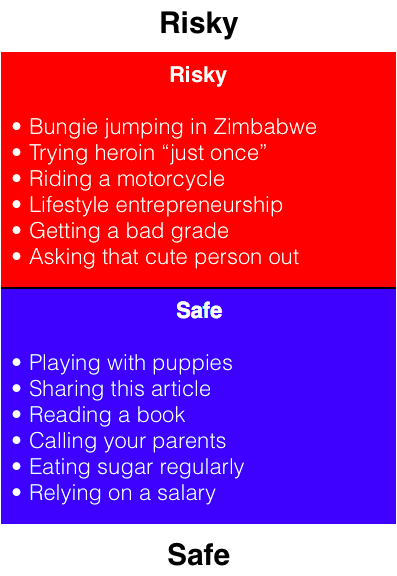
Let’s dig in on each of the categories. Most of the things we’ve talked about so far: getting a low grade in a class, starting a business, going after being a creative, these are in the “land of opportunity.” They’re perceived to be risky by many people, but when you analyze them more carefully, you discover that they’re actually safe.
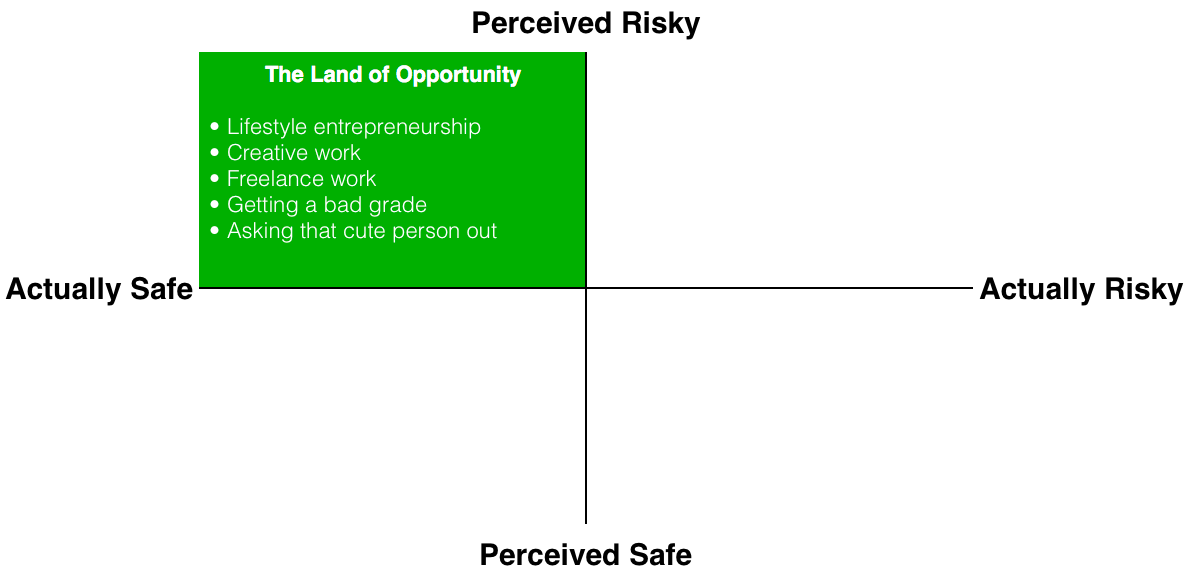
Things like riding a motorcycle, bungee jumping in third world countries, trying heroin “just once”, these are the TRULY risky things. If you were to dig in on them, odds are you’d come to conclusion that “yup, they’re in the right place.”
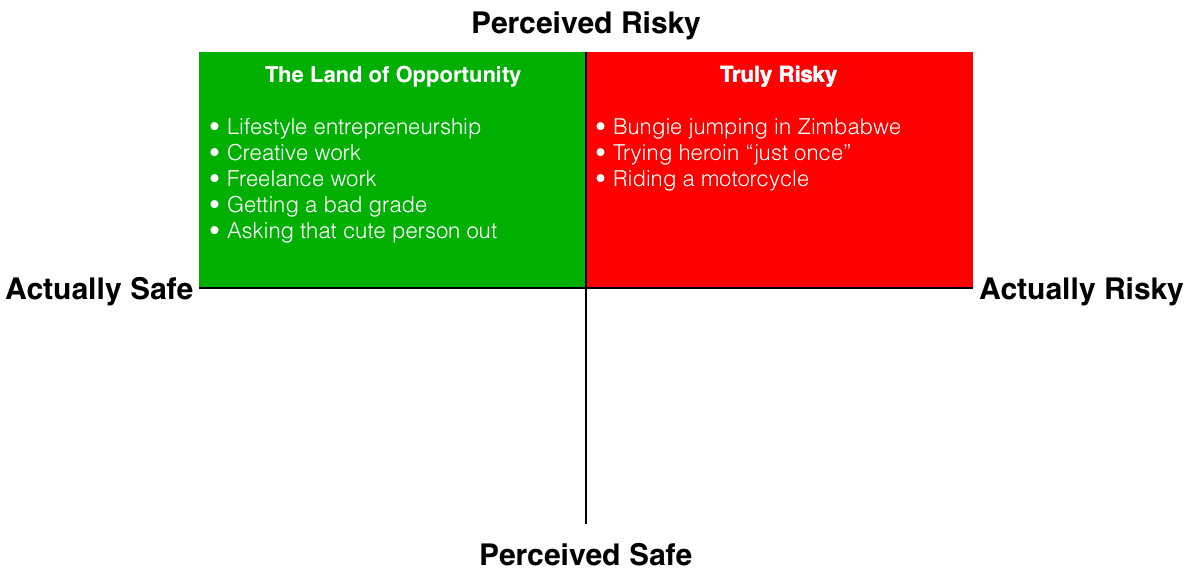
But we also have the opposite of the land of opportunity. These are choices that we perceive as safe, but that have a host of hidden risks that come with them. This is the “Danger Zone of Misjudged Risk.”
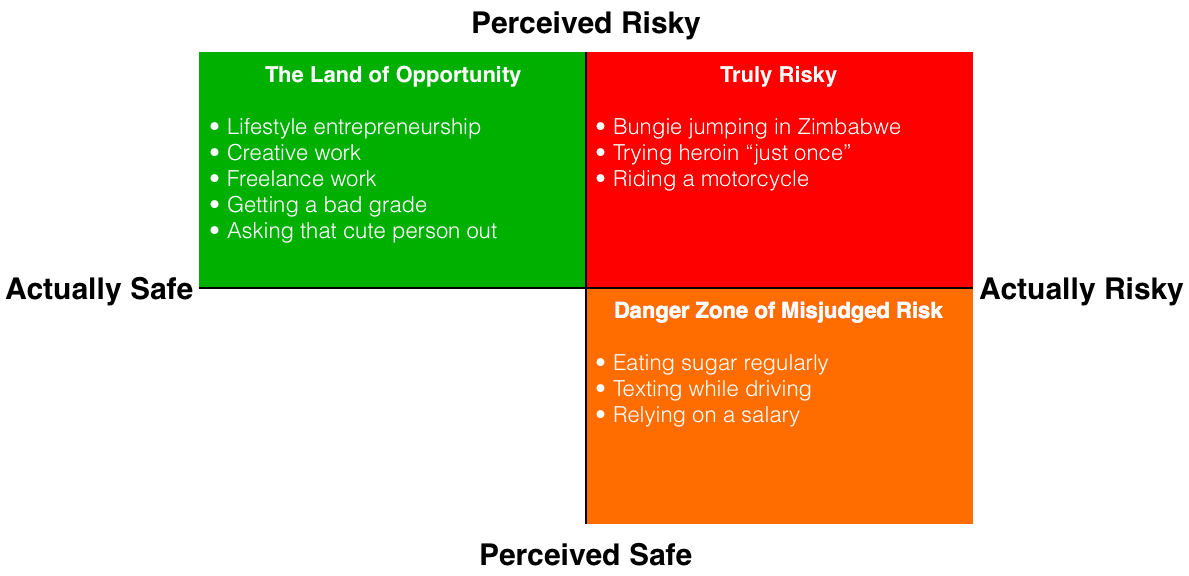
And, finally, we have the truly safe things you should simply do more of, that no one would mistake as being risky in the first place:
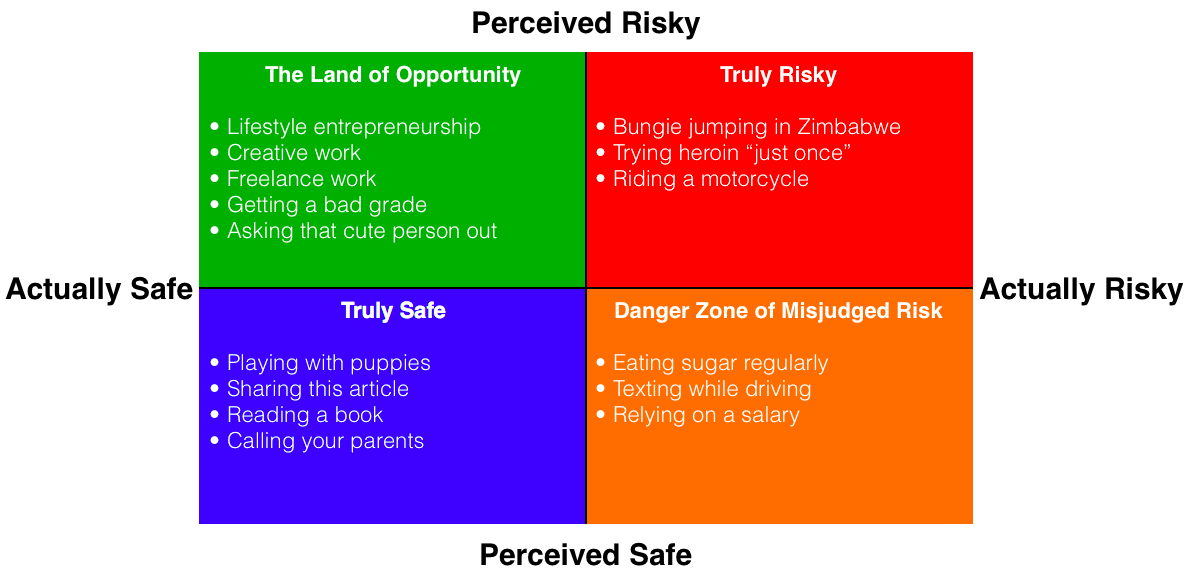
What’s most interesting is the comparison of the Danger Zone of Misjudged Risk and The Land of Opportunity. For most people, the items in the “Land of Opportunity” would be in the “Truly Risky” category, and the “Danger Zone” items would be in the “Truly Safe” category.
Since they’re operating on that 2D spectrum, they simply accept what other people say is or isn’t risky, and never question it for themselves. That leads them to be afraid of things they shouldn’t be, but also, to not fear things they should.
So going back to the goal of developing a more rational assessment of risk in order to go after what you want, what you need to do is start categorizing fears based on what’s truly risky, and what’s onlyperceivedas risky.
There are a few ways you can do that.
Method 1: Questioning
The simplest way to get at the root of why something seems risky is to keep asking “why?” or “why do you think that?” or related questions until you can’t get any deeper. This will give you a sense of whether your perceptions of riskiness are based on sound data, or if they’re coming from some external source like “my parents said so.”
For example, let’s take the case of traveling for a year after college.
“That’s risky!”
“Well, why?”
“Because it’ll be hard to get a job when you get back!”
“Well, why?”
“Because you’ll have been traveling for a year, and companies want current students!”
“Well, why do you think that?”
“Well, because that’s what all of my friends did and my parents said.”
“Is it possible that you just haven’t seen someone do it, so you assume it’s a bad idea?”
“Yeah, I suppose…”
Let’s take another example, say, ditching corporate work for freelancing.
“That’s risky!”
“Well, why is it risky?”
“Because how will you make enough money?”
“Plenty of freelancers support themselves just fine, is there any other reason it’s risky?”
“How will you advance your career?”
“Is it possible that you could advance your career without a clear-cut corporate path? And maybe even advance it faster?”
“Yeah, I suppose… But it still seems risky!”
“Does it maybe seem risky because you don’t see as many people doing it?”
“Yeah maybe…”
In both of these cases, as in many others, the only reason you think it’s risky is because “someone said so” or you haven’t seen it done. If you can get over those as being poor measuring sticks, you can mitigate many of the misplaced fears of riskiness.
But, you might still hesitate, which is why it’s also useful to try a process called…
Method 2: Fear Setting
This method was popularized by Tim Ferriss in The 4-Hour Workweek. What you need to do is take out a piece of paper, and write down the horrible, terrible, absolute worst possible case scenario possible imaginable for what you’re considering doing.
Let’s use our college student considering going a non traditional route and working on a startup:
Well, my parents might disown me and stop paying for my college. I could fail and be set back a year in looking for jobs. My grades could suffer. I could be made fun of by my friends. I could lose money in the process. Maybe the company will do poorly and someone will write an article making fun of me.
Then, we can break these down one by one:
- Well, my parents might disown me and stop paying for my college. This is a common fear, and one that some parents use as a threat, but I don’t know that any parents would actually DO it. They’d still want you to get an education even if you’re doing a poor job of it, so it’s unlikely they’d pull you out of school. Plus, see the discussion above. You just have to convince them that you’re safe.
- I could fail and be set back a year in looking for jobs. We already covered concerns like these. Just because something is unconventional doesn’t mean that it can’t help you, and odds are, this would improve how you look to potential employers.
- My grades could suffer. Not a big deal since you’re competing on a different playing field now.
- I could be made fun of by my friends. Good, this will be a useful tool for weeding out your loser friends and finding the good ones who support you and believe in you.
- I could lose money in the process. Unlikely if you’re smart in the process you use.
- Maybe the company will do poorly and someone will write an article making fun of me. Kind of like when Gawker called Tesla the “failure of the year”? Besides, this is incredibly unlikely, no one cares about us that much.
Even after all of that, you might still be a little concerned. Simply take each fear, and on a scale of 1-10, rank how horribly life changing it would be. And before you do, consider how quickly you could get back to where you are now for each one as well. E.g. “I could get my grades back on track in a semester, so that’s no big deal.”
Now, once that’s done, also write out a list of all the amazing things that could happen. For example:
- The company could take off and I could be the next Zuckerberg!
- I could find work that I love and am excited about!
- I could meet some amazing people who are also working on cool companies!
- My friends would respect me for going after something they’re afraid of!
- I wouldn’t be miserable after graduation!
- I’d be significantly more interesting to employers if I did apply for a regular job!
- I wouldn’t hate school so much!
For each of these, put a 1-10 ranking of how positively life changing they would be. Now compare your potential for a positive life changing experience to your potential for a negative life changing experience.
Doesn’t it look like this could be MASSIVELY positively life changing, with it being unlikely that it would be permanently negatively life changing?
What you’ll find is that many opportunities previously thought of as “risky” will have significantly higher possibility of being positively life changing. This is the Land of Opportunity.
Method 3: Transmutation
If you’ve been following along and questioning your perceptions of risk, you might feel a little scared at this point. Not the kind of fear that comes from the sense that something is risky, rather the fear of anticipation that can come from realizing that what you thought was risky is actually a huge opportunity.
Our emotions did not evolve in the modern world. They were meant to keep us alive 100,000 years ago when our main concerns were finding food, not getting eaten by lions, and having lots of sex. Just about every one of your emotions comes from one of those places.
The feeling of fear that we get today is the modern version of “there’s some animal charging at me.” When we perceive a chance of a negative outcome and don’t understand the true odds, our “that’s risky” instincts tell us that it’s safer to run away than to dive in headfirst.
But what’s curious is the physiological aspects that induce that emotion. When you perceive something as scary, your body starts pumping out adrenaline, your heart rate increases, maybe you get a little sweaty, your pupils constrict. This is our “ this might kill me so I better run ” reaction, but it’s also our “ oh man I’m about to mess up this lion right now ” reaction.
Our body does the same thing whether we’re about to run away in fear or about to earn our spot in Project Mayhem. It’s merely our interpretations of those physiological changes that lead to different emotional states. That reaction you might have to a new, unknown opportunity can be seen as fear and trepidation, or it can be seen as excitement and courage. It simply requires you to reframe the biological response in your mind.
This is common advice for public speakers and other performers. The feeling you get in the pit of your stomach that novices interpret as stage fright never goes away for the expert performers, they just learn to think about it differently. Instead of seeing it as “oh man I’m so scared to go on” they see it as “my body is getting me PUMPED UP to go on.” It’s the same physical reaction, just a radically different mindset.
So the next time you’re considering something and immediately have that “this is risky and scary” feeling, assess your reaction more carefully, and see how you can turn that physiological response into an emotional response of courage and excitement instead of fear.
In Practice
You have the tools now to face any situations you may have previously considered “risky” with a fresh outlook. We’ve covered how un-risky commonly encountered situations are, how we can separate out the perceived risky from the actually risky, and three tactics for reducing our initial “this is risky” reactions.
Now it’s up to you to put them into practice. What’s something you want to do, or some goal you aspire towards, that you’re not going after because you think it’s risky? Have you gone down the “Why” chain on it? Have you gone through Fear Setting? Have you tried Transmuting that sense of fear into excitement? Are you sure you aren’t just lacking exposure to good examples of similar goals being pulled off?
I’m confident that when you think about it and really dig into it, what you’re considering is not risky at all.
After I published this article, my uncle pointed out an important distinction between things that are “challenging” and things that are “risky.” You canread more about that here.

